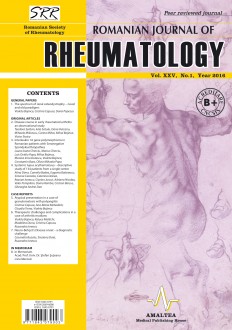SELECT ISSUE

Indexed

| |

|
|
|
| |
|
|
|

|
|
|
|
|
|
| |
|
|
HIGHLIGHTS
National Awards “Science and Research”
NEW! RJR has announced the annually National Award for "Science and Research" for the best scientific articles published throughout the year in the official journal.
Read the Recommendations for the Conduct, Reporting, Editing, and Publication of Scholarly work in Medical Journals.
The published medical research literature is a global public good. Medical journal editors have a social responsibility to promote global health by publishing, whenever possible, research that furthers health worldwide.
SYSTEMIC LUPUS ERYTHEMATOSUS – DESCRIPTIVE STUDY OF 134 PATIENTS FROM A SINGLE CENTER
Alina Dima, Camelia Badea, Eugenia Balanescu, Simona Caraiola, Caterina Delcea, Razvan Ionescu, Ciprian Jurcut, Adriana Nicolau, Valer Pompilian, Doina Ramba, Cristian Baicus and Gheorghe Andrei Dan
ABSTRACT
Introduction. Systemic lupus erythematosus (SLE) is a chronic autoimmune disease of unknown origins with increasing prevalence worldwide. Lupus clinical and immunological features are complex and heterogeneous, but peculiar characteristics in different population were described.
Aim. Description of specific clinical and biological features of SLE patients.
Methods. 134 patients fulfilling the 2012 SLE Systemic Lupus International Collaborating Clinic criteria were enrolled. Baseline characteristics and biological features (such as sex, age, age at disease onset, disease duration, tobacco and alcohol habits, cardiovascular and fracture risk factors) were collected in all consenting patients prospectively included. Also, disease activity scores such as Systemic Lupus Activity Measure (SLAM), European Consensus Lupus Activity Measurement, Systemic Lupus Erythematosus Disease Activity Index, and accrual damage Systemic Lupus International Collaborating Clinics/American College of Rheumatology index were assessed when data needed for these scores were available.
Results. A number of 134 SLE patients, majority of feminine sex (89.6%) were enrolled. The mean ± SD age at inclusion and onset age were 46.4 ± 12.9 years and 36.5 ± 12.2 years. 19.4% of patients included were current smokers. Regarding comorbidities, 8.5% associated diabetes and 41.8% hypertension. Anti- deoxyribonucleic acid antibodies were identified in the antecedents of only 50.4% of the searched cases; higher proportion of positivity was found for lupus anticoagulant, respectively 70.9%. Joint involvement was the most frequent clinical criterion used to sustain the lupus diagnosis (110 patients, 82.1%), while the hematological one the most frequent involvement at inclusion (50 patients, 37.3%). 67.9% of patients presented SLAM score results less or equal to 5 points, 10.4% results between 5 and 8 points, and 21.6% of more or equal to 8 points. The majority of patients enrolled were under corticosteroid treatment (109 patients, 81.3%) and also an important part was receiving Hydroxychloroquine (108 patients, 80.6%).
Conclusion. In this cross-sectional study, we presented important data related to general characteristics, biological parameters, immunological features, disease scores, and treatment principles in a single-center sample of SLE patients.
Keywords: systemic lupus erythematosus, disease scores, corticosteroid
